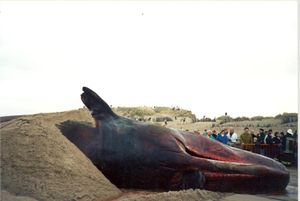PCB and heavy metals in beached sperm whales
Heavy Metals, Organochlorines and Polycyclic Aromatic Hydrocarbons in Sperm Whales Stranded in the Southern North Sea During the 1994/1995 Winter
Context of the study
In the winter of 1994-1995, 21 sperm whales beached along the North Sea shorelines. The reason for the mass stranding was that these sperm whales became trapped in the North sea. Because of the unfavorable conditions in the North Sea the animals starved and ultimately stranded. However, these animals can be used to obtain valuable information on accumulation and excretion mechanics of stable pollutants and the overall health status of these long-living marine mammals.
Content of the study
7 of the 21 sperm whales beached on Belgian and Dutch territory. One of them died at least a day before beaching, the six others died shortly after stranding. The muscles, livers kidneys and fat of these 7 whales were examined for the presence of heavy metals, organochlorines and PAH's.
Main results
High concentrations of cadmium (up to 300 µg/g dry weight in the kidney), total mercury (up to 130 µg/g dry weight in the liver) and PCB's (up to 5 µg/g in blubber) were retrieved in these sperm whales. Methylmercury averaged 4% of total mercury concentrations in the liver and 90% in the muscles. Concentrations of zinc, lead, nickel, chromium and copper were considered low compared to other species, which is because sperm whales live much more remote than most other species. It's remarkable that less than 66% of the Cd found in the livers and kidney's were bound to metallothioneins. Therefore the remaining 33% might not have been detoxified. This is in contradiction to findings from the Pacific Ocean where 90% of the Cd has been found to be bound to metallothioneins. The inorganic mercury in the liver was found to be bound to selenium rather than to metallothioneins. Although other studies have shown that stable pollutants (like PCB and Mercury) tend to accumulate in marine mammals with increasing age, this study didn't find higher concentrations of any contaminant in the oldest animal. This animal was estimated to be at least older than 60. This means that he has been born in the pre-organochlorine period and therefore didn't accumulate any PCB's or pesticides in the first decades of his live. Considering that he started accumulating organochlorines in the 1950's and 1960's, it becomes normal that his contamination levels are similar to the ones of the younger sperm whales, which were born in this period.
Organochlorine concentrations in the blubber were found to be low compared to other species. Since similar levels have been shown to have caused reproductive and immune-deficiency problems in marine mammals, this doesn't necessary imply lack of effect.
The low PAH levels were consistent with literature data and are considered unlikely to affect marine mammals.
You can find more information of this study though this link
